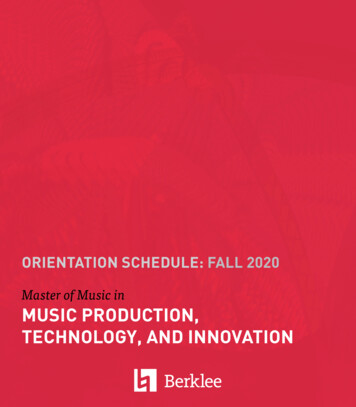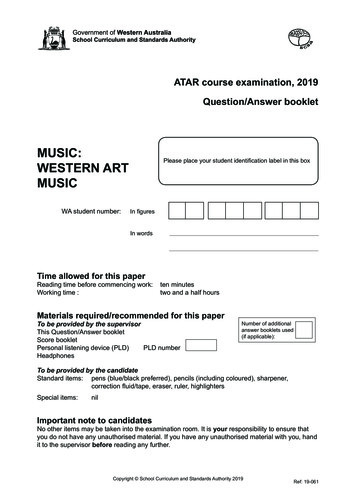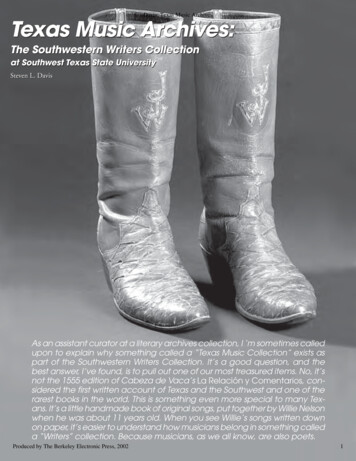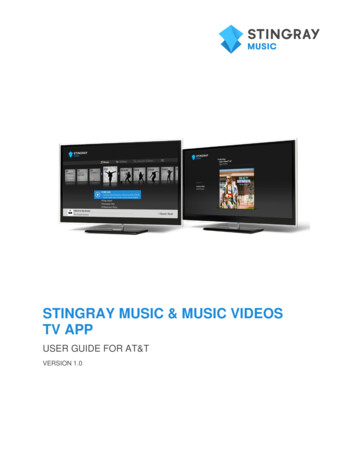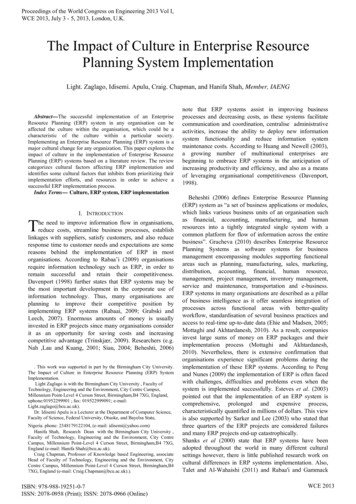
Transcription
The Impact of Computer Music Technology on MusicProductionBy Steven ThornelyHow has computer technology impacted on the artistic practice of musical composition?Abstract:The composers’ capacity to implement computer technology into the music-making processes isexplored in this text. A debatable concept is highlighted which explains that technology is notinfluencing composing techniques but instead, composers are appropriately mobilizing technologyto their advantage. A philosophical approach is adopted, with the ideas endorsed by relevantexamples.
The deployment of computer technology on the music industry has affected almost all facets ofmodern music. The last fifty years has seen the most primitive uses of computer generated soundevolve into the digital domain that is today’s music. Computer technology has led the evolution offormat, medium, performance, and distribution of audio over this time. On the other hand,technology has not impacted on the artistic practise of musical composition; rather, the moderncomposer - in concordance with a changing culture, economy, and trend towards popular music has been given the ability to manipulate computer technology to create a sound that is accepted bythemselves and consumers of music. In essence, the computer has become a tool that has the abilityto capture, score, manipulate and perform a composer’s work (Dodge, 1985, p. 11), while only thecomposer can manifest an original sound. The development of this idea with reference to a recentchart-topping song, Fireflies by Owl City is explored here. First, it is essential to touch on themethods of a composer before the time of computer technology.To identify why the computer has become an essential tool for the modern composer, the methodsof the great composers who lived before the age of computers can be juxtaposed with today’spractises. Consider Beethoven, who was composing about 150 years before the dawn of computerorchestration. Beethoven, like any composer of his time, would transcribe the song in his head to ascore. Kennedy (2010) notes, “[Beethoven’s] sketchbooks show how he laboriously developed anidea from sometimes banal beginnings to the final version,” demonstrating the arduous process ofscoring by hand. The score would then be interpreted and rehearsed by musicians until the piecewas ready for performance in front of a formal audience. Conversely, the example of Fireflies wascomposed, scored, recorded and distributed entirely by the man behind Owl City, Adam Young, inhis parent’s basement (Sisario, 2009). Young’s use of computer technology will later beinvestigated, but this example forefronts the amalgamation of methods Beethoven had to use, beingthe capturing, scoring, and performance of the work. To begin this process, a flow chart of thecomputers role in modern music is useful (See Figure 1.0 and 1.1).The role of the computer as a capturing tool for composers’ ideas is the first of these factorschronologically through the development of a piece of music. It is one that holds possibly the mostdebate as to who is leading this innovation – the composer or the computer. Figure 1.1demonstrates how the composer is indeed leading this advance, where the computer is merelyassisting the composer in capturing original ideas. The ‘Song in imagination’ segment is alongsidethe computer such to say that although both the composer and the computer have some input overPage 2 of 7
how an idea will sound, the composer is still responsible for the underlining musical initiative.David Cope, the inventor of a computer composition programme rejects the idea that composershave the only creative drive in the musical production process. He says, “When I'm composing allday, I'm programming. When I'm programming, I'm composing" (as cited in Cheng, 2009), as if tosay that the computer can have the same creative input into a composition as his own imaginationdoes. Douglas disagrees with Cope’s perspective by stating, “Science [referring to computertechnology] and art do not speak the same language and it would be disastrous if music becamecompletely automated” (1973, p. 6), as in the way Cope describes. In support for Douglas, theinflux of computer driven sound – not computer driven composition – can be explained as a logicalresponse by modern composers to the ‘computer culture’ that has arisen over the last 20 years.To elaborate on the point that the computer has not assumed position of the composer, theinfluences of the example artist, Owl City, can be identified to understand from where thecompositional direction came. One could hypothesize that songs produced with the aid ofcomputers would sound completely different to those captured without the use of computers. Thisis not the case. To demonstrate: Owl City’s Fireflies has been criticised for in a sense ‘plagiarising’the sound of indie-pop band ‘The Postal Service’ (Sisario, 2009). Continuing, Ben Gibbard, singerfrom The Postal Service proclaims that ‘The Beatles’ are an influence to his compositions (Larkin,2010). Therefore, the analogue-produced music by The Beatles has indirectly impressed directionupon the music by Owl City. The evolution of musical ideas through time as demonstrated by thesecomposers’ shows that the sounds made in collaboration with computers are not completely new;they are simply an adaption of ideas from the past. This said, the computer does play an importantpart in the actual implementation of composers’ ideas.The role of the computer as an ‘idea capturing assistant’ is largely due to the scoring, recording,and editing qualities that technology has brought to music. In terms of Figure 1.0, this refers to thepre-technology method of hand-scoring a piece of music, a process which has become a job for thecomputer. There is little debate that this feature of the computer can positively contribute to acomposer’s efficiency as well as capability. Chavez (although before the time of computertechnology) encapsulates this with his statement concerning the phonograph , “Surely progress inthe physical and mechanical sciences determines a progress in art, since the artist of today has athis command the resources of yesterday plus many more” (1937, p. 19). These so-called‘resources of today’ in this context are most notably in the form of scoring and digital audioPage 3 of 7
workstation softwares. Within these programs, creations like the click-track, digital sampling,MIDI, and a realm of digital audio effects have become available (Miranda & Wanderley, 2006, p.222).Each of these innovations has allowed modern composers to accurately write down, develop andsculpt their ideas in a medium that composers such as Beethoven did not have available. OwlCity’s Fireflies holds evidence as to the use of these resources in modern music. Young, thecomposer and producer of the piece, proclaims himself that, “All of it is done in the box, so tospeak” (as cited in Bosso, 2010). He elaborates by confirming his use of the popular digital audioworkstation ‘Pro Tools’ and within this, utilizing sequencing, sampling and auto-tune, along withother digital devices. Without doubt, this ability of the computer to effectively score and edit asong is one of the most important elements in the composer’s ability to employ computertechnology in present age of music.The performance of music is the final purpose of the computer in aiding the composer in theproduction process (See Figure 1.0 and 1.1). The ability of the computer to assume the role ofperformers by playing a sound or piece of music at the operators’ discretion has become arevolutionary addition to the composer’s ‘box of tools’. Hence, the computer has become themusician (figuratively) by means of playback. While performance through playback devices suchas record and tape players has been available for some time, the implementation of the CompactDisc, MP3 and portable music players - thanks to the computer – have made performance oforiginal work more affordable for composers (Manning, 2010). This has expanded the horizons ofcomposers, and catalysed the industry so much so that, “In the modern world, where context candepend on the mere flip of an on-off switch and a portable MP3 player, it is hard to imagine thedays when all music came from face-to-face performances” (Titon, 2009, p. 20). These ‘virtualperformances’ became even more pliable with the introduction of the internet to the music industry.The internet has become the largest disseminator of music in recent times, and has been especiallyuseful for low-budget composers to distribute original music. It has helped in the composition fieldbecause of its ability to deregulate long-standing presumptions concerning which types of musicshould be released to the public, and therefore be composed by songwriters. It has meant thatcomposers can write what they want to write, and “It is easier, quicker, and more flexible forconsumers to find and acquire the music they want” (Styvén, 2007). Young from Owl CityPage 4 of 7
perfectly embodies this scenario with his utilization of the internet. He has been described as a“MySpace phenomenon” (Edgar, 2010) - MySpace being a popular social networking website - androse to success initially through internet distribution. It is thus clear that the internet has thecapacity to disseminate and in a sense, perform composers’ works, and is undoubtedly an importantcomponent of technology’s role in facilitating the job of a composer.In conclusion, computer technology has provided a means of capturing composers’ ideas, scoringand editing them, and distributing and performing the works. The development of recordingtechnology, software applications, the internet and portable music have created a world where asong can go from a composer’s head, to being available to an audience of millions within hours.Composers have led - and will continue to lead - the evolution of modern music with the assistanceof computer technology as a tool and resource for further musical exploration. In essence, thecomposer has not become an instrument for the computer; rather, the computer has become aninstrument for the composer.Page 5 of 7
Resources:Bosso, J. (2010). Owl city reveals live and studio setup: "I use auto-tune". Retrieved March 28, 2010,from 45.Chavez, C. (1937). Toward a new music: Music and electricity. New York: Da Capo Press.Cheng, J. (2009). Virtual composer makes beautiful music—and stirs controversy. Retrieved March 20,2010, from sy.ars.Dodge, C. (1985). Computer music. New York: Schirmer Books.Douglas, A. (1973). Electronic music production. London: Pitman Publishing.Edgar, M. (2010). Owl city takes new york by storm. Retrieved May 30, 2010, wl-city-takes-new-york-b b 552461.html.Kennedy, M. (2010). Beethoven, Ludwig van. The Oxford Dictionary of Music. Retrieved May 28,2010, from Oxford Music Online er/article/opr/t237/e1035.Larkin, C. (2010). Death Cab For Cutie. Encyclopaedia of Popular Music. Retrieved May 28,2010, from Oxford Music Online er/article/epm/73134.Manning, P. (2010). Computers and Music. Grove Music Online. Retrieved May 30, 2010, fromOxford Music Online er/article/grove/music/40583.Miranda, E., & Wanderley, M. (2006). New digital musical instruments: Control and interactionbeyond the keyboard. Middleton, WI: A-R Editions, Inc.Sisario, B. (2009). From mom’s basement to the top of the chart. Retrieved March 28, 2010, 1owl.html? r 2.Styvén, M. (2007). The Intangibility of Music in the Internet Age. Popular Music and Society.Retrieved May 30, 2010, from ProQuest database, (Document ID: 1305618211).Titon, J. T. (2009). Worlds of music: An introduction to the music of the world’s peoples (5th ed.).Belmont, CA: Schirmer/Thompson Learning.Page 6 of 7
Appendix:Figure 1.0Before computer technology:Composer Song in imagination Score Performers AudienceFigure 1.1Use of computer technology:Composer Song in imagination Computer AudiencePage 7 of 7
The Impact of Computer Music Technology on Music Production By Steven Thornely How has computer technology impacted on the artistic practice of musical composition? Abstract: The composers’ capacity to implement computer technology into the music-making processes is explored in this text. A debatable concept is highlighted which explains that technology is not influencing composing .


